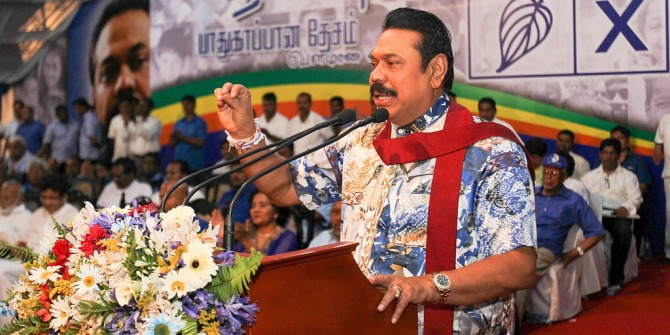 Asanga Welikala reviews the constitutional changes introduced by Sri Lanka’s former president Rajapaksa to remove key limitations on presidential power. He argues that Rajapaksa’s surprise defeat this month suggest the basic ideals of democratic government have deeper roots in the Sri Lankan polity than have been visible in the recent past.
Asanga Welikala reviews the constitutional changes introduced by Sri Lanka’s former president Rajapaksa to remove key limitations on presidential power. He argues that Rajapaksa’s surprise defeat this month suggest the basic ideals of democratic government have deeper roots in the Sri Lankan polity than have been visible in the recent past.
In a dramatic reversal of electoral fortunes, Mahinda Rajapaksa was ousted from power in Sri Lanka’s presidential election on 8 January. This was not an outcome that was contemplated as a possibility by even the most optimistic of Rajapaksa’s critics barely three months ago, when his regime appeared to enjoy what seemed like the impregnable support of the Sinhala-Buddhist majority. Part of the reason for Rajapaksa’s appearance of invincibility had been the constitutional changes he had introduced to consolidate his regime, after his victory in May 2009, in the war against the Liberation Tigers of Tamil Eelam (LTTE). Instead of offering a political settlement to address Tamil and other minority aspirations after the war, the Eighteenth Amendment to the Constitution in September 2010 abolished the two-term limit on presidential tenure and removed key limitations on presidential power.
Term limits are a key feature of presidential systems, given that an independently elected president is not responsible to the legislature in the same way as a parliamentary executive. And Sri Lanka’s two-term limit had been one of the only limitations on an executive presidency that was otherwise constitutionally omnipotent. The removal of the limit was exacerbated by the fact that in Sri Lanka, the presidential term is not fixed, i.e. a sitting President can choose the best timing for his re-election after the lapse of four years of the six year term. The abolition was directly related to Rajapaksa’s dynastic ambitions and would have allowed him (had he won re-election) to continue in office until such time as his son and heir – both affectionately and derisively known as ‘Namal Baby’ – was ready to assume the mantle for which he was being groomed. Continuous re-election would not have seemed difficult, given Rajapaksa’s willingness to crush any significant form of dissent with legal and extra-legal methods, and to use the power and resources of the state as his personal property.

The Eighteenth Amendment also removed important controls on presidential power imposed by the Seventeenth Amendment, enacted in October 2001. This amendment had attempted to depoliticise key state functions by establishing independent commissions to oversee the judiciary, the police, the public service, the electoral administration, and bribery and corruption. It had also required presidential appointments to key posts including judges of the superior courts, the Attorney-General, the Auditor-General, and the Inspector General of Police to be vetted through a non-partisan Constitutional Council chaired by the Speaker of Parliament. The Seventeenth Amendment was a rare piece of constitutional legislation in that it was passed with near-unanimous support in Parliament. Even more remarkably in Sri Lanka, it sought to limit rather than expand the powers of the executive. Facilitating executive convenience has been a recurrent motivation for constitutional change ever since the first republican constitution was enacted in 1972.
Rajapaksa’s Eighteenth Amendment, for which the necessary two-thirds majority in Parliament had been obtained by inducing the crossover of opposition parliamentarians with financial rewards and ministerial office, completely eviscerated the Seventeenth Amendment framework. It removed key functions and powers of the independent commissions, and it replaced the Constitutional Council with a Parliamentary Council. The President was only obliged to ‘seek the observations’ of this ineffective body when making appointments to high posts. It was also chaired by the Speaker, which happened to be Chamal Rajapaksa, the President’s brother.
The effect of these constitutional changes, and the revivification of an enveloping presidential sway over all organs and institutions of the state, was immediately apparent. Through the co-optation of key high-ranking personnel, the armed forces, the police, and the public service were all politicised and became appendages of the regime. This was exemplified in the untrammelled power and authority wielded by Gotabhaya Rajapaksa, a brother of the President, across the government and beyond. He was notionally only the Secretary to the Ministry of Defence, a public servant, but he presided over a widespread militarisation of ordinary administrative functions. This included the ‘beautification’ of Colombo through the Urban Development Authority, involving the forced eviction of slum-dwellers, and the appointment of ex-military personnel as Governors of the Tamil-speaking Northern and Eastern Provinces, with implicit instructions to obstruct the autonomy of those elected Provincial Councils. The strength of the armed forces was not reduced after the war, but expanded to include roles in commercial activities and school and university education. The mechanisms for ensuring public financial accountability and transparency, for the integrity of the electoral process and of law and order, were all rendered irrelevant. The usual distinctions between the ruling party, the government, and the state that are central to a functioning democracy became meaningless, and through this, the bellicose, chauvinist, nationalist ideology of the Rajapaksa state began pervading the polity at large.
But in registering the arrival of the new control – and nepotistic – model of government, there was nothing more dramatic than what happened to the independence of the judiciary. Chief Justice Shirani Bandaranayake was once seen as a Rajapaksa loyalist; her husband had controversially accepted appointments as head of the Sri Lanka Insurance Corporation and the National Savings Bank. A Supreme Court judgment written by her dismissed pre-enactment challenges to the constitutionality of the Eighteenth Amendment Bill out of hand, or at least, with conspicuously poor and incomplete reasoning. Petitioners’ arguments, based on principles of republicanism and liberal constitutionalism, that constitutional limits on presidential powers and terms were indispensable to ensuring the accountability and legitimacy of the executive were rejected on the simplistic ground that the provision for periodic presidential elections fulfilled all the constitutional requirements of democracy.
Then for reasons that are not yet public knowledge, her husband was dismissed from his government positions, and arrested and charged with bribery. This coincided with a change of judicial attitude in the Chief Justice. There followed a series of decisions in which her court became increasingly critical of the government, culminating in the determination of unconstitutionality of the Divi Neguma Bill. This measure was intended to establish a massive development programme under the Minister of Economic Development, Basil Rajapaksa (also a brother of the President), together with the now characteristic opportunities for corruption and waste. The Supreme Court, however, declared that a number of its provisions were inconsistent with the powers devolved to the Provinces under the Thirteenth Amendment, which would have to be deleted, or if not, passed through a special procedure involving obtaining the consent of the Provincial Councils.
By now, the Rajapaksas were not in the habit of deferring to the Supreme Court or being restrained by procedural niceties. They immediately took steps to impeach the Chief Justice, and using their large and pliant parliamentary majority, she was ousted from office by a process that did not even bother to follow the basic elements of the established constitutional procedure for the removal of senior judges. She was replaced by Mohan Peiris, a sycophantic lawyer and legal advisor to the family, who once appointed, did not even pretend to exercise the independence and impartiality expected of the office of the Chief Justice.
In the absence of an independent judiciary and law enforcement, the path was cleared for the corruption and wastage bordering on plunder that followed. It allowed the cartelisation of the economy by members of the extended Rajapaksa family and their associates, whether through simple influence-peddling, or creaming commissions and cuts from development projects and the sale of public property, through manipulation of the stock market and insider trading, and through effective immunity from prosecution for straightforwardly criminal activities such as drug smuggling and the illegal importation of ethanol used for illicit liquor brewing.
The more the regime and its coterie of clients enmeshed themselves in the apparatus of the state, the less it seemed that a democratic change of government was possible. The rule of law, human rights, and canons of constitutional democracy, even if only fitfully observed in the past, seemed to have vanished altogether, and populist sources of regime legitimacy rooted in Sinhala-Buddhist chauvinism seemed to have replaced them as the new substance of Sri Lankan politics. Vigilante groups of Buddhist monks with close connections to the regime began a campaign of demonising Tamil, Muslim, and Christian minorities, and on occasion even organised mini-pogroms, with total impunity. They have rapidly disappeared from the scene after the fall of the regime, demonstrating their dependence on the latter.
In retrospect, however, it appears that these excesses had alienated all sections of Sri Lankan society except the diehard core of the regime’s constituency. When President Rajapaksa called an early presidential election for January 2015, even his detractors expected the now customary electoral cakewalk. But an opposition that had been weak and fractured for many years came together to provide a reasonably coherent and attractive programme that placed constitutional reforms at its heart. In particular, the common opposition’s manifesto proposed repealing the Eighteenth Amendment, and going further, the abolition or a substantial reduction of the powers of the executive presidential system itself. The monarchical incumbent had invited the electorate to express its gratitude to him for winning the war and for his mega-development projects. The opposition instead chose to remind Sri Lankans of their self-worth and dignity as citizens of a democratic republic, and of their political heritage as South Asia’s oldest democracy. Against the odds, the latter prevailed, to deliver a thin but decisive mandate against presidential authoritarianism, and for the re-establishment of democracy, legality, and constitutionalism in Sri Lanka’s governing arrangements.
The new administration has set about its 100-day reform programme purposefully since the election, but it is still too early to tell whether all of it will succeed. For now, however, what might be said is that the basic ideals of democratic government seem to have deeper roots in the Sri Lankan polity than were visible in the recent past, and while the electorate’s tolerance for populist authoritarianism has a high threshold, it clearly is not unlimited.
Note: This article gives the views of the author, and not the position of the India at LSE blog, nor of the London School of Economics. Please read our comments policy before posting.
About the Author
 Dr Asanga Welikala is ESRC Teaching Fellow in Public Law at Edinburgh Law School, and Associate Director of the Edinburgh Centre for Constitutional Law. His new edited collection, Reforming Sri Lankan Presidentialism: Provenance, Problems, and Prospects, will be published by the Centre for Policy Alternatives (CPA) in Sri Lanka in February 2015, and will be openly accessible online shortly thereafter.
Dr Asanga Welikala is ESRC Teaching Fellow in Public Law at Edinburgh Law School, and Associate Director of the Edinburgh Centre for Constitutional Law. His new edited collection, Reforming Sri Lankan Presidentialism: Provenance, Problems, and Prospects, will be published by the Centre for Policy Alternatives (CPA) in Sri Lanka in February 2015, and will be openly accessible online shortly thereafter.







